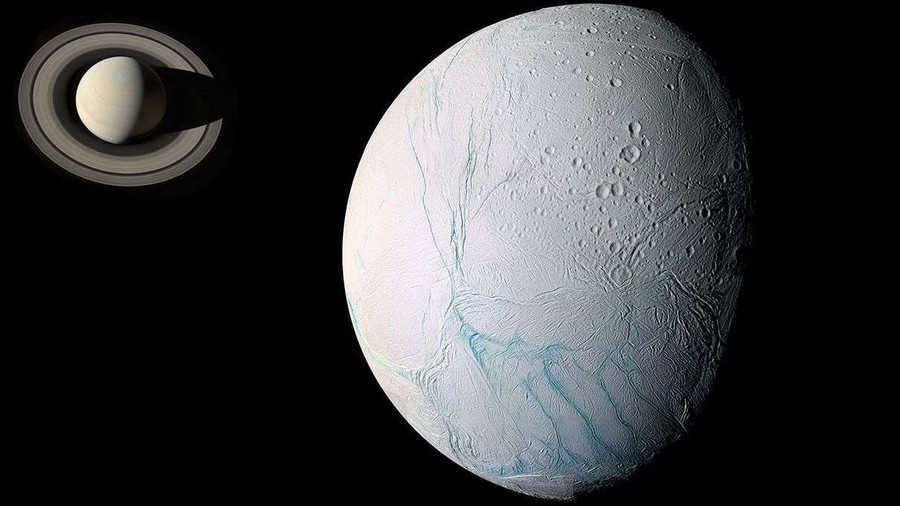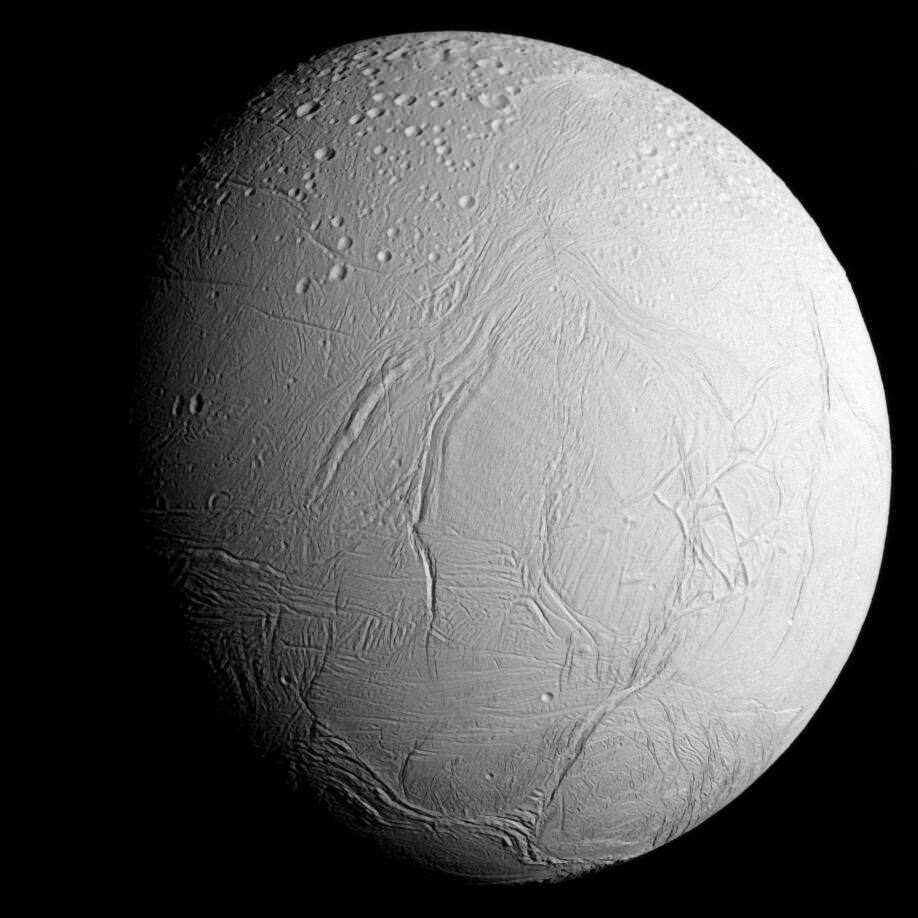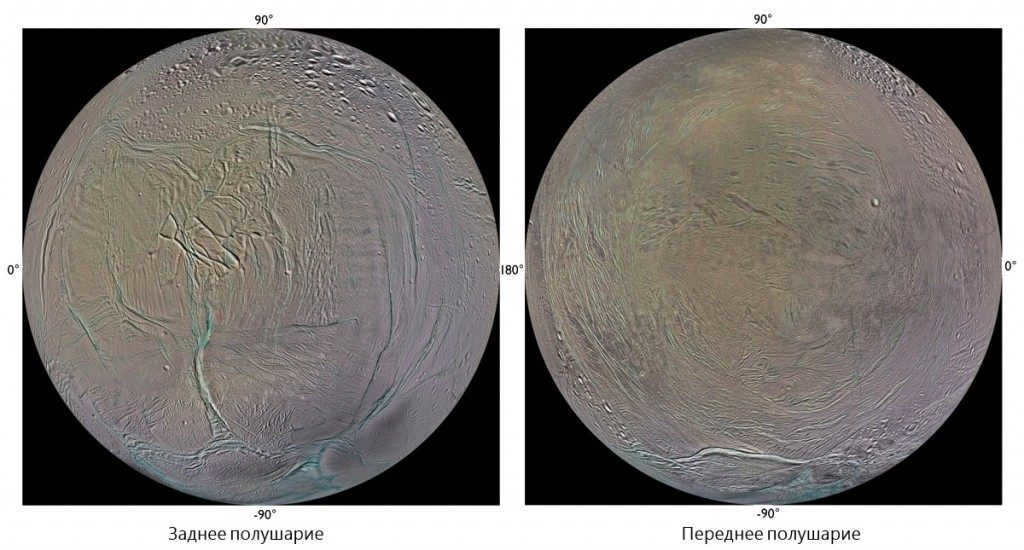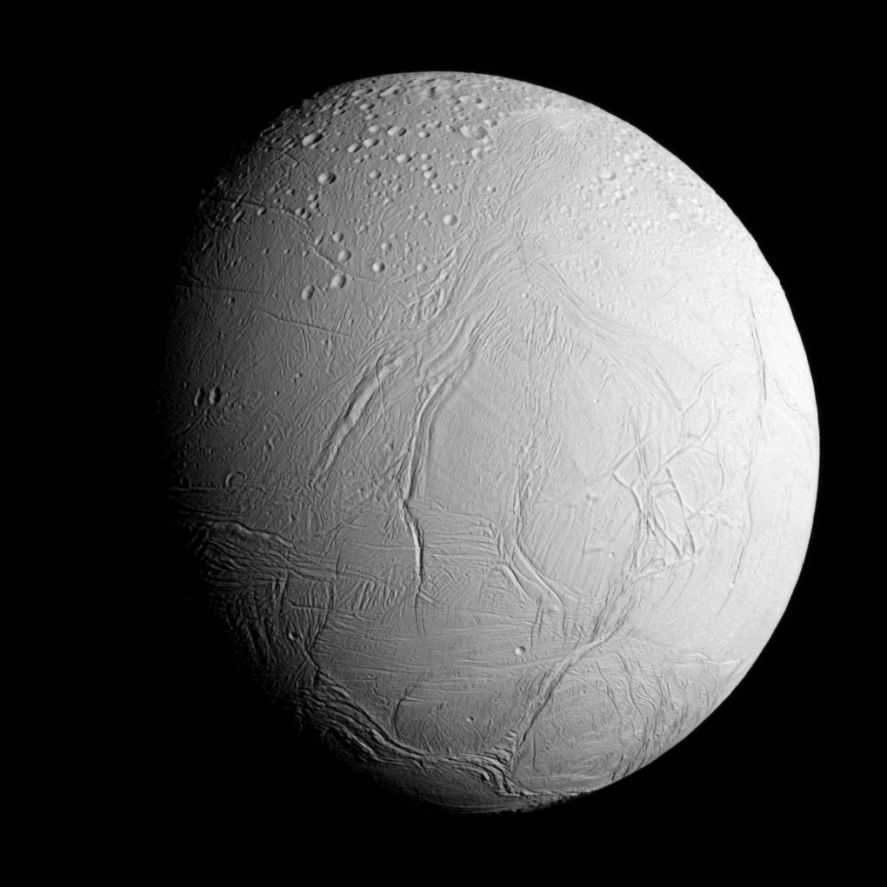

Enceladus is Saturn’s moon, and it is a fascinating celestial body with many interesting features. Let’s explore some key details about this tiny satellite.
First of all, Enceladus has a diameter of 505 kilometers, making it relatively small compared to other moons. To put it into perspective, it would fit within the borders of the state of Arizona. However, despite its size, Enceladus has captured the attention of scientists and researchers around the world.
One of the most intriguing aspects of Enceladus is its icy surface. The entire moon is covered in a thick layer of ice, creating a stunning visual appearance. But what lies beneath this icy shell is even more fascinating.
Enceladus is believed to have a subsurface ocean of liquid water. This means that underneath the icy exterior, there is a vast body of liquid water in contact with the rocky bottom. The presence of liquid water is significant because it is a key ingredient for the development of life as we know it.
Despite the extremely cold temperatures on Enceladus, the existence of liquid water raises the possibility of life forms existing in this distant moon. The interaction between the water and the rocky surface could create chemical reactions that could potentially lead to the formation of life.
Scientists have also discovered geysers on Enceladus. These geysers shoot water vapor and icy particles into space, providing valuable insights into the composition and dynamics of the moon. The presence of geysers further supports the idea of an active and potentially habitable environment on Enceladus.
The exploration of Enceladus has been made possible through the Cassini mission. The Cassini spacecraft, launched by NASA, has provided us with unprecedented images and data about this fascinating moon. Thanks to Cassini, we have been able to uncover many of the mysteries surrounding Enceladus.
In conclusion, Enceladus is a small but remarkable moon orbiting Saturn. Its icy surface, subsurface ocean, geysers, and potential for life make it a captivating subject for scientists and a fascinating topic for children to learn about.
Satellite Enceladus: Key Numbers Explained for Kids
- The average distance it orbits from its parent planet is 238,037 kilometers.
- Approximate distance from its parent planet – 236,918 kilometers.
- Farthest distance from its parent planet – 239,156 km.
- Time it takes to complete one orbit – 1.37 days.
- Speed at which it orbits – 45,487.3 km/h.
- How elliptical its orbit is – 0.0047.
- Average radius – 252.1 km.
- Distance around its equator – 1,495,652 km.
- Density of its surface – 0.113 m/s 2 .
The discovery and naming of Enceladus – an explanation for kids
On August 28, 1789, William Herschel decided to test his brand new 1.2 meter telescope. He was not disappointed with its power, as he became the first person to discover the moon of Saturn called Enceladus.
Enceladus had not been observed for a long time due to its small size. It orbits Saturn at a distance of 238,037 kilometers. It might be interesting for young readers to know that Enceladus is one of the brightest objects in our solar system, although it is difficult to see because of the brightness of Saturn. Herschel was lucky because he made his observations during Saturn’s equinox, which reduced the glare from the rings.
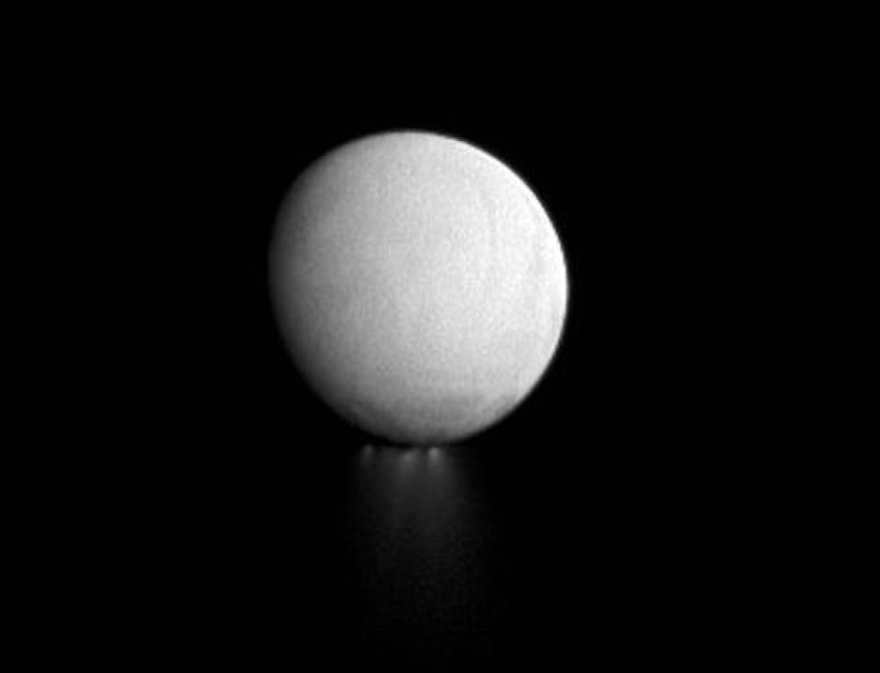

The jets of Enceladus are cast into shadow as the winter night descends. The picture was published on January 7, 2013.
Children should be aware that Enceladus remained unnamed for a significant period of time. It was not until John Herschel published his study in 1847 suggesting that Saturn’s moons should be named after Titans that the moon received a name. Before that, it was simply referred to as Saturn II.
In mythology, Enceladus was depicted as having snake-like limbs. In a battle with the gods of Olympus, Athena impaled it with the tip of her spear. All of the moon’s formations are named after characters from One Thousand and One Nights.
An Explanation for Children: The Freezing Breath of Enceladus Satellite
It’s important for young minds to understand that the moon, Enceladus, possesses five distinct types of landscapes. Among them, craters can reach up to a width of 35 kilometers. In contrast, other regions appear smooth and unmarked, suggesting a more recent formation. Additionally, cracks, plains, and surface faults can also be observed.
Despite its small size, Enceladus emits an astonishingly bright light. It’s crucial to convey to children that this phenomenon is a result of its icy surface, which reflects about 90% of the light it receives. However, due to its inability to absorb heat, the temperature on Enceladus drops to a bone-chilling -330°C.
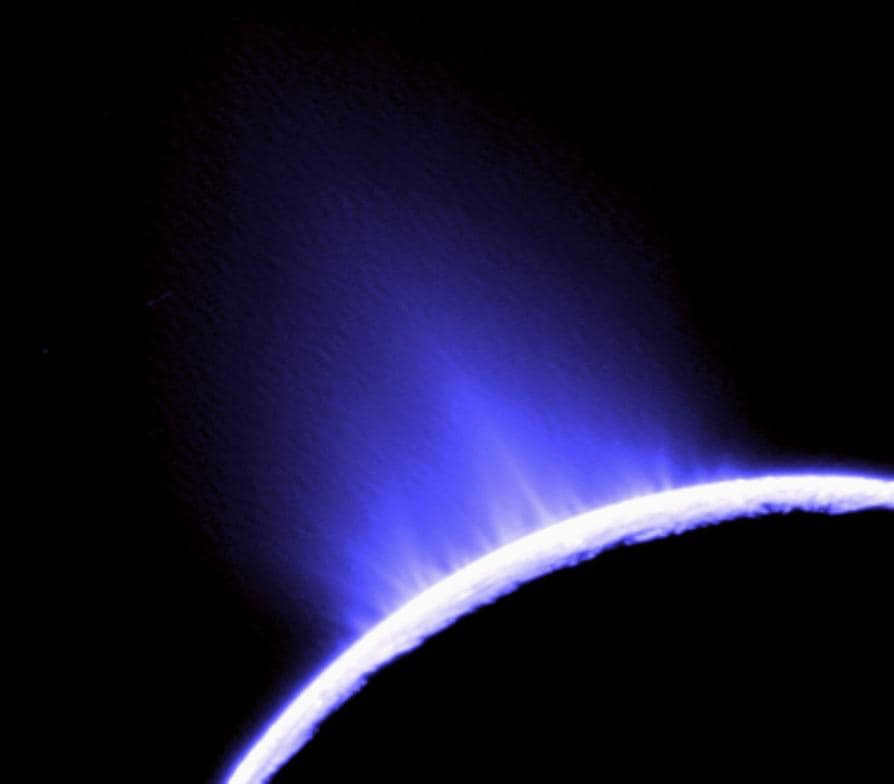

Water fountains on Enceladus. The image was taken in October 2007 by the Cassini spacecraft.
Enceladus has a diameter that is 1/7 of the size of our Moon. It is ranked sixth in terms of size. The moon has a flattened spheroid shape with a bulge at its equator.
Despite its small mass, scientists were astounded to discover an atmosphere that dominates the heated south pole. The spacecraft found fissures – known as “tiger stripes” – that periodically release material into space. Some of this material fuels the atmosphere, while a larger portion escapes into space. Saturn’s E-ring (which is a million kilometers wide) also receives its share.
Enceladus is home to numerous active geysers. The gravitational forces at play cause cracks to open and close, as the moon’s elliptical orbit (1.37 days) constantly changes its distance from the planet. It is hypothesized that these geysers may be linked to an underground ocean. If this is the case, a spacecraft would not need to physically dive into the ocean, but could instead collect samples directly from the emissions of the geysers.
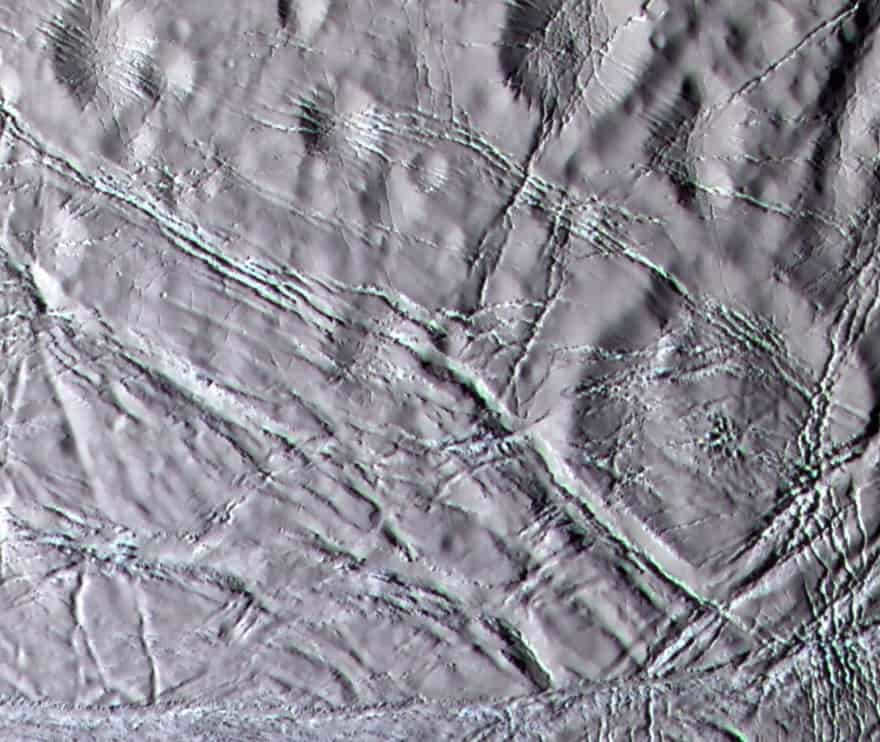

A colorful picture depicting a ‘snowy’ lunar landscape situated north of the geologically active south polar ridges. The landscape is characterized by the presence of narrow fractures.
The strength of geysers increases as the moon moves away from the planet, but the gas output remains constant. It is important for young individuals to be aware that the geysers have been observed to release a reduced amount of material since their discovery by Cassini in 2015. The exact cause for this phenomenon is still unknown.
Despite the frigid temperatures, the presence of liquid water is possible on Saturn’s satellite Enceladus thanks to the antifreeze properties of ammonia, which prevents the water from freezing. The spacecraft was able to detect complex chemicals and organic compounds in the vapor plumes, making Enceladus a promising candidate for the existence of life.
We hope you found the story and description of Enceladus, Saturn’s satellite, fascinating. When sharing this information with children, it’s a good idea to provide them with interesting facts, photos, videos, and illustrations to enhance their learning experience. They will also enjoy exploring our 3D model of the solar system, complete with a map of Saturn and a view of its satellites. Unfortunately, due to their small size and great distance from Earth, these moons cannot be observed in real time using an online telescope.
- Dione: a crater-filled moon that orbits Saturn.
- Hyperion: a unique and porous moon of Saturn.
- Japetus: Saturn’s moon with a Yin-Yang pattern.
- Mimas: Saturn’s moon that resembles the Death Star.
- Rhea: Saturn’s moon known for its dirty snow-like surface.
- Tefia: Saturn’s icy satellite.
Enceladus is the 6th largest moon in Saturn’s moon family. It is characterized by streak-like layers of blue ice and fascinating jets of water ice. It is known to have a significant volume of water, making it a potential target in the search for extraterrestrial life. Let’s explore some interesting facts about Saturn’s moon Enceladus.
Discovery and designation
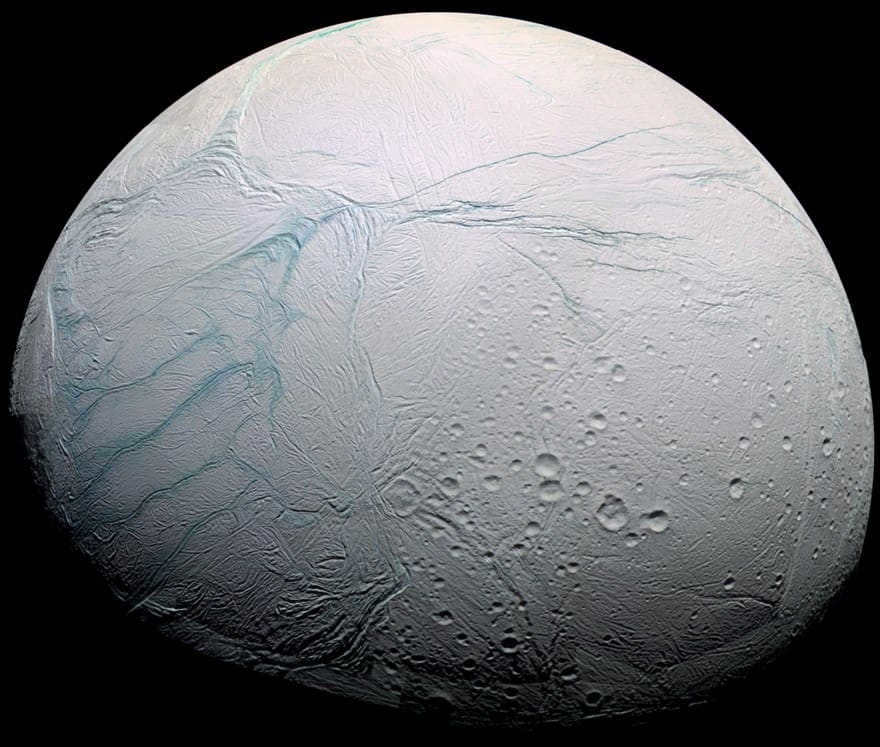

"Tiger stripes" serve as sources of icy eruptions. The picture was captured by Cassini in 2009.
William Herschel discovered the satellite in 1789. It was given its name in honor of one of the titans. In fact, all of Saturn’s satellites were named after the Greek titans based on John Herschel’s suggestion. However, all of its features are named after characters and places from classical history.

Dimensions, weight, and path of revolution
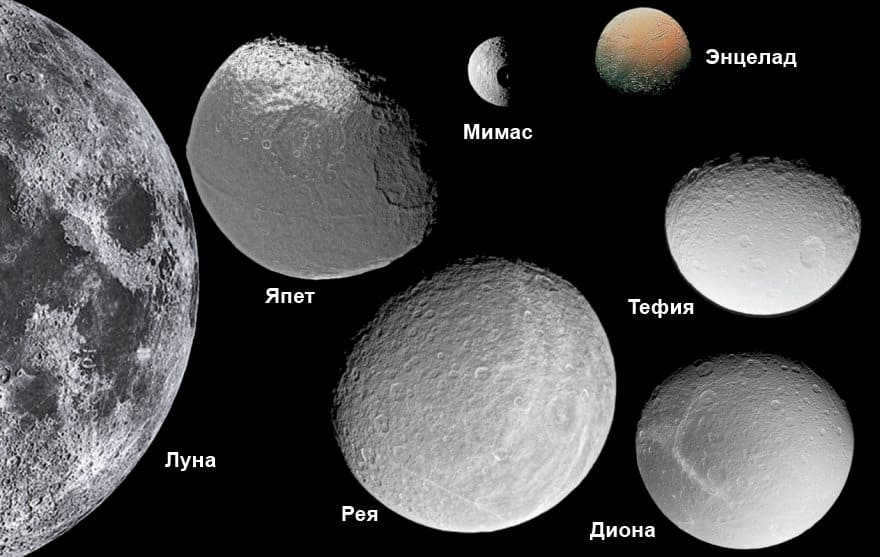
Comparing the sizes of the Moon and Saturn’s major satellites
The Moon has a radius of 252 km, which is 0.0395 times the radius of Earth. Its mass is 1.08 x 10 20 kg, which is 0.000018 times the mass of Earth. With an eccentricity of 0.0047, the Moon’s average distance from Earth is 237,948 km. It takes the Moon 32.9 hours to complete one orbit around Earth. Additionally, the Moon is in a 2:1 resonance with Saturn’s moon Dione. This resonance helps maintain the Moon’s eccentricity and is also the main source of heat for the Moon’s geological activity.
From this information, we can conclude that Enceladus is a satellite of the planet Saturn.
The primary characteristics of Enceladus, a satellite of Saturn
The rotational and orbital periods of Enceladus align perfectly, resulting in a gravitational lock.
Makeup and Surface
With a density of 1.61 g/cm3, Enceladus is denser than the other moons in its vicinity. It is primarily composed of iron and silicates. Enceladus boasts an active core, a liquid ocean, and an icy mantle. Below is an image illustrating the structure of Saturn’s moon, Enceladus.
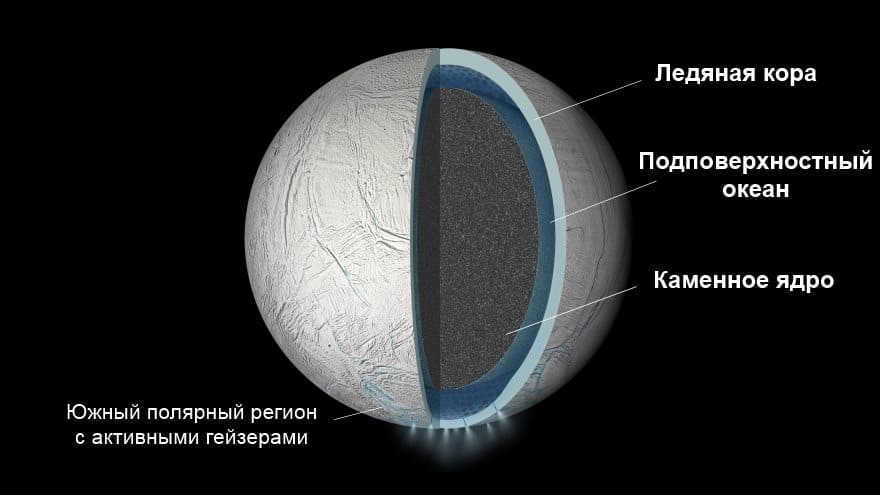

The measurement of lunar gravity conducted by the Cassini spacecraft has provided hints indicating the existence of an internal ocean beneath the south pole region.
Since 2005, there has been ongoing debate regarding the presence of a subsurface ocean, with evidence coming from the observation of jets containing water vapor emanating from the south polar area. These jets have the capability to expel 250 kg of vapor per second at a velocity of 2189 km/h and reach heights of 500 km.
In 2006, it was discovered that these jets were responsible for replenishing Ring E, and their emissions include not only water vapor but also methane, molecular nitrogen, carbon dioxide, formaldehyde, propane, and acetylene.
An experienced tarotologist will be available to answer any questions you may have.
What is in store for you in the future? How will the dynamics of the relationship unfold? What is the optimal choice to make?

The analysis reveals that there is significant pressure in the south polar plume. The intensity of the eruptions varies depending on the position of the orbit. The strength of the jets increases fourfold when Enceladus is at its maximum distance from the planet.
This animation demonstrates the maximum height a person could jump while on the surface of the Sun.
The existence of underground water on Enceladus was also discovered by the Cassini mission in 2014. The presence of a 10-kilometer-thick ocean was confirmed through gravity measurements.
In addition, in 2005, Cassini observed a heat release from the south pole that could not be explained by solar heating. The temperature was unusually high, which suggests that the satellite experiences geologic activity, especially when considering the presence of geysers.
A research on lunar libration indicates that the entire icy crust detaches from the rocky core, revealing the presence of an ocean. The depth of this ocean can reach up to 26-31 kilometers.
The lunar surface is categorized into five distinct types of relief: craters, plains, scarps, depressions, and grooves. Interestingly, the craters on the moon are named after characters from the famous book “One Thousand and One Nights,” such as Shehirizada, Diyar, Anbar, and many others.
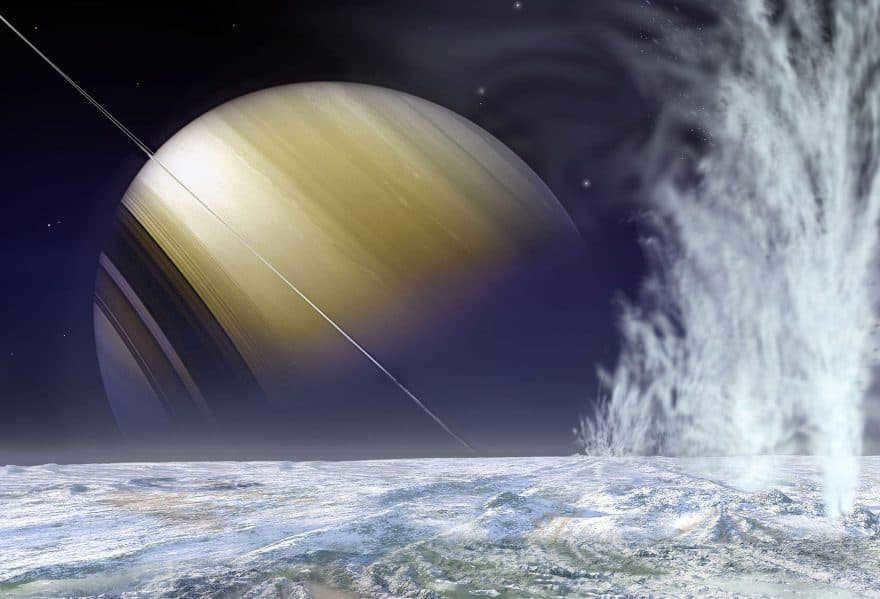
A glimpse of Saturn as seen from Enceladus. The foreground is adorned with erupting geysers.
The smooth plains of Enceladus are now adorned with a fresh layer of ice, resulting in an albedo of 1.38. The presence of few craters suggests that they are relatively young, with an age of only a few million years. The ancient regions exhibit not only craters but also significant deformation.
One of the most intriguing features of Enceladus is its rift canyons, which can stretch for up to 200 km, span a width of 5-10 km, and go as deep as 1 km. These formations are relatively young and possess distinct topography, intersecting with older structures.
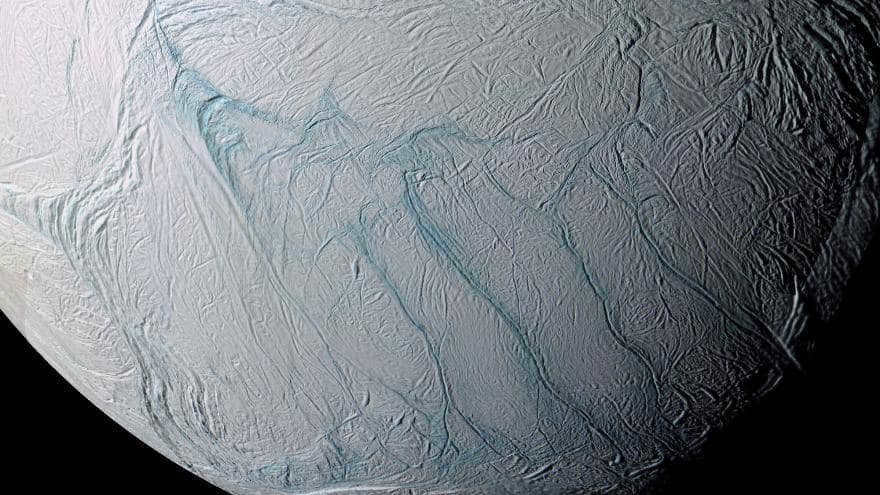
A sequence of faults that resemble tiger stripes can be observed on the surface of Enceladus.
There are also linear grooves present on the ridge bands, although some of them have been erased due to impacts from nearby craters. Additionally, there are smaller ridges measuring approximately 1 km in length. The prominent feature, known as the “tiger stripes,” consists of a series of cracks bordered by ridges on both sides. These formations are located in the southern polar region and are surrounded by water ice.
An experienced tarot reader will provide answers to the following inquiries:
What does the future hold for you? How will your relationships unfold? What is the right course of action to take?

Atmosphere
Comparable to Titan in its atmospheric layer, this planet is formed by cryovolcanoes that expel gases and vapor onto the surface. The initial indication of this phenomenon was discovered by Cassini in 2005. Analysis from a magnetometer revealed that the gases were predominantly located in the southern polar region, where the atmospheric layer is thinner.
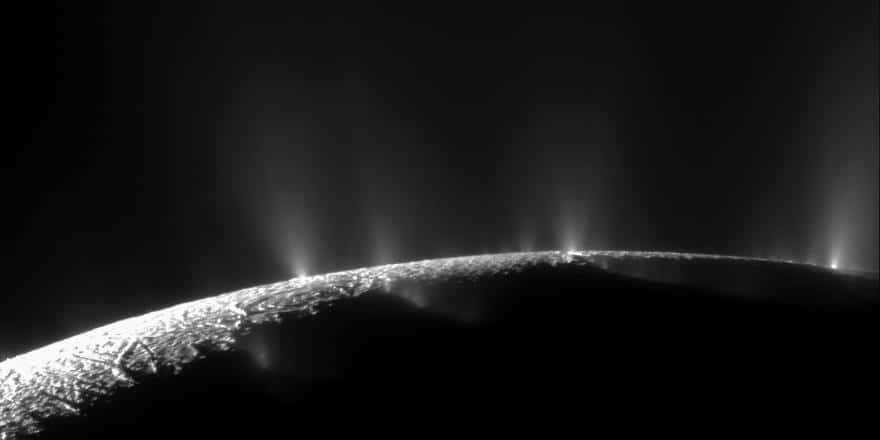
Water vapor spewing from the southern pole of Enceladus
The atmosphere is brimming with water vapor (91%), molecular nitrogen (4%), carbon dioxide (3.2%), methane (1.7%), and traces of propane, formaldehyde, and acetylene.
Inhabitability
Ever since the discovery of geysers and indications of a subsurface ocean, scientists have come to regard Enceladus as a potential haven for life. However, due to its high reflectivity, the temperature on the moon remains at a frigid -198°C.
The resonance with Dione alters the orbital eccentricity, resulting in tidal heating. This phenomenon explains the geologic activity observed on Enceladus and the existence of a warm ocean closer to its core. In 2015, Christopher Glain developed a model of the ocean with an alkaline pH level ranging from 11 to 12. This environment facilitates the production of molecular hydrogen, which can serve as a source of energy for methanogenic microbes.
Research
Despite the discovery of the satellite in the late 18th century, it wasn’t until the Voyager mission in the 1980s that we started gaining knowledge about its characteristics.
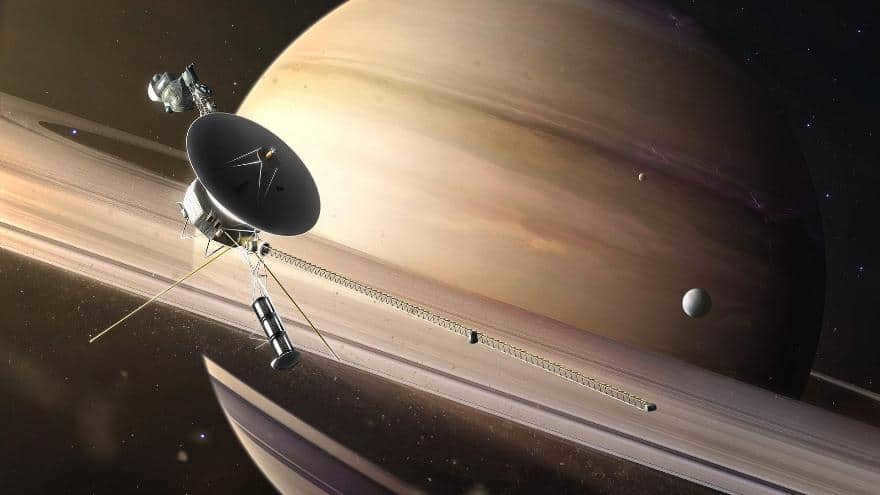
Voyager 1 reaches Saturn and its moon system
This expedition measured the size of the moon, as well as its surface characteristics (reflecting almost 100% of sunlight), and its position in the E-ring. Voyager 2 transmitted superior pictures.
Cassini approached Enceladus in 2005. He observed water geysers and collected proof supporting the existence of a subsurface ocean. Enceladus is now regarded as one of the most promising targets for exploration due to the accessibility of water.
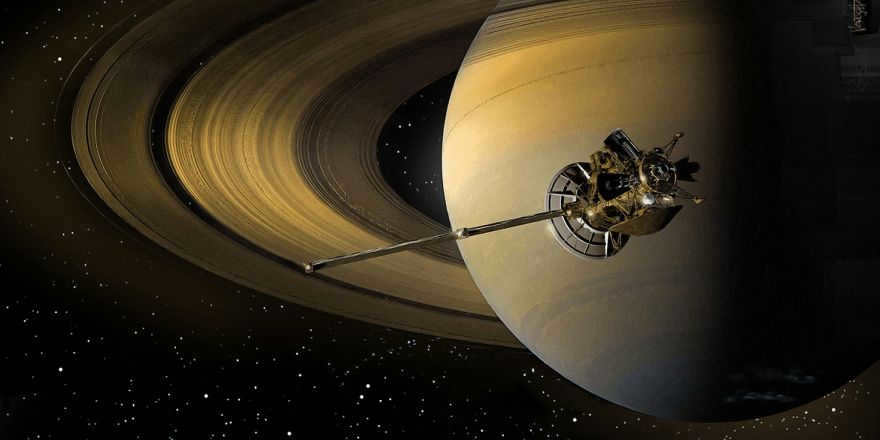

An artistic representation of the Cassini lander
The final encounter of Cassini occurred in 2015, during which it came within 1,839 kilometers of the moon. The spacecraft’s instruments captured surface characteristics such as craters, ridges, and faults, suggesting that the moon has experienced geological processes.
Enceladus is now widely recognized as an important object for scientific study, leading to various proposed missions to explore its mysteries. One such mission, proposed in 2013, involves sending a lander to retrieve a sample from the moon. If approved, this ambitious project would be launched in the 2020s and would take approximately 15 years to complete. Another mission aims to not only study Enceladus but also visit Titan and collect samples of the jets. This idea was considered by the European Space Agency (ESA) in 2007 as part of the TandEM mission, and in 2009, NASA also became involved with the Enceladus Joint Saturn Moon mission (EJSM).
If you have questions about your future, your relationships, or the right decisions to make, our team of experienced tarotologists is here to provide answers. Don’t hesitate to seek guidance and gain insight into what lies ahead.

Despite being located far away, Enceladus, one of Saturn’s moons, hides numerous captivating and intriguing characteristics for scientists. The existence of an ocean, jets, and icy surface indicate the possibility of life. Moreover, scientists can examine a sample of the jets from the atmosphere instead of having to send a vehicle to the moon’s surface. Don’t forget to explore the surface map of this moon.
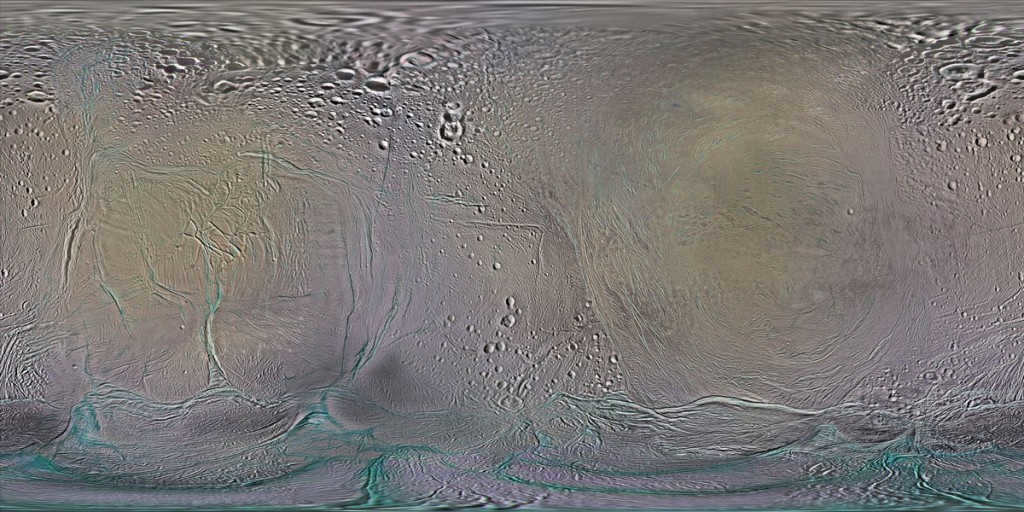
Enlarge the image by clicking on it
Photographs
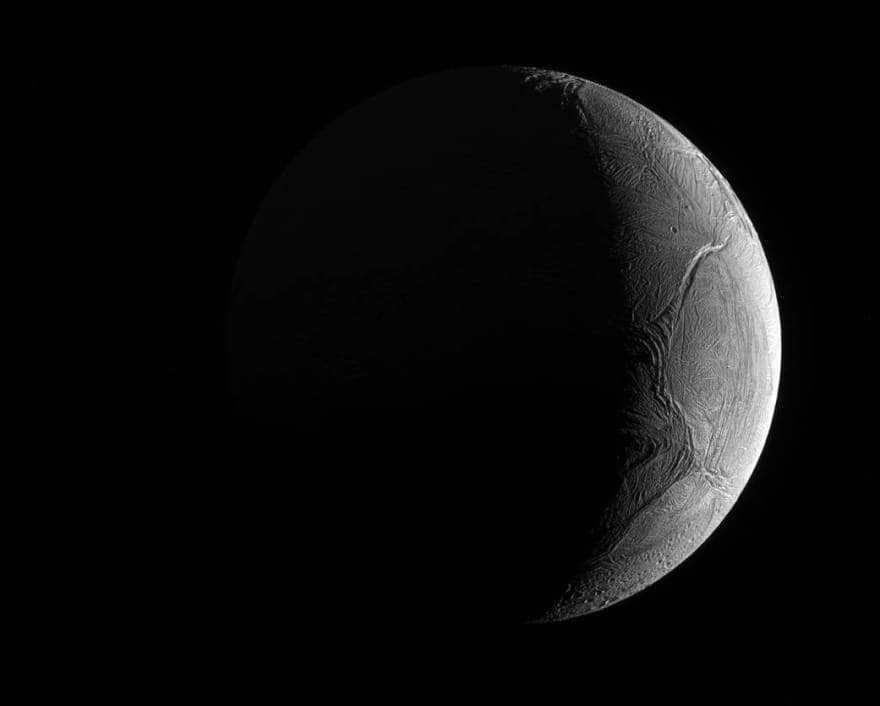
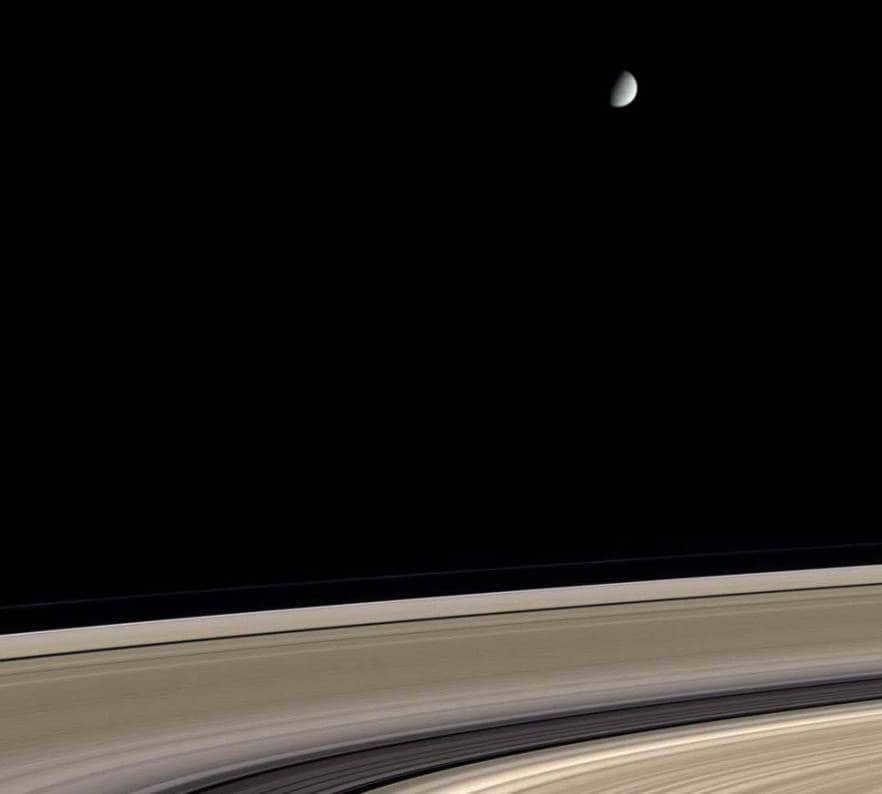
Enceladus, Saturn’s icy moon, orbits above the planet’s stunning ring system in the colorful view captured by the Cassini spacecraft. The rings, made mostly of pure water ice, contain traces of meteorite dust and are believed to be ancient, possibly dating back hundreds of millions of years. Enceladus, on the other hand, is composed almost entirely of water ice and has somehow managed to avoid contamination, although the reasons for this remain unknown. The moon has a diameter of 505 kilometers.
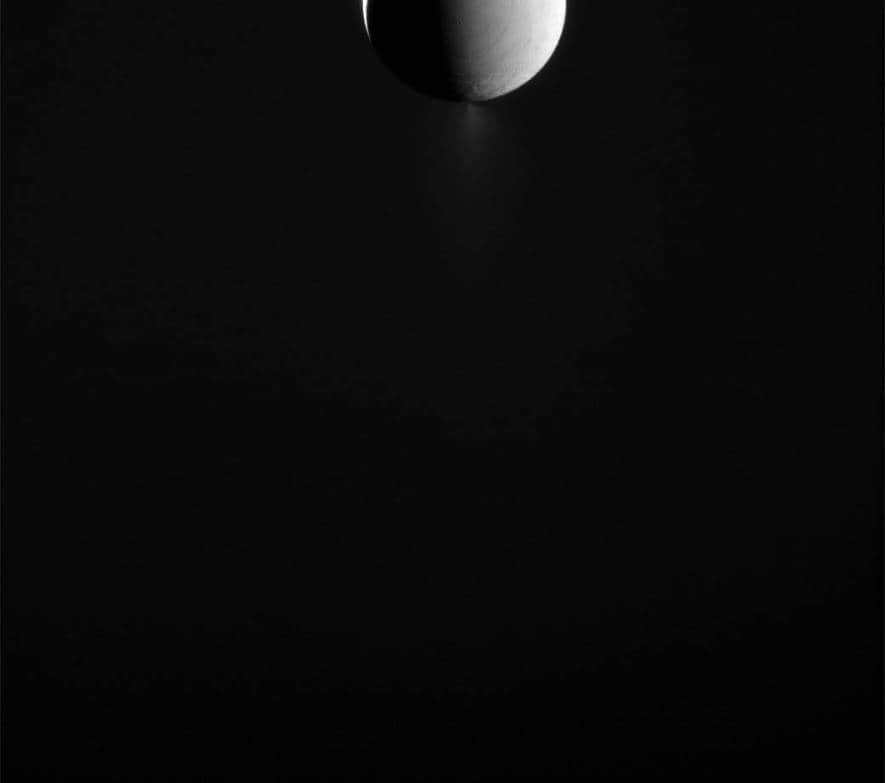
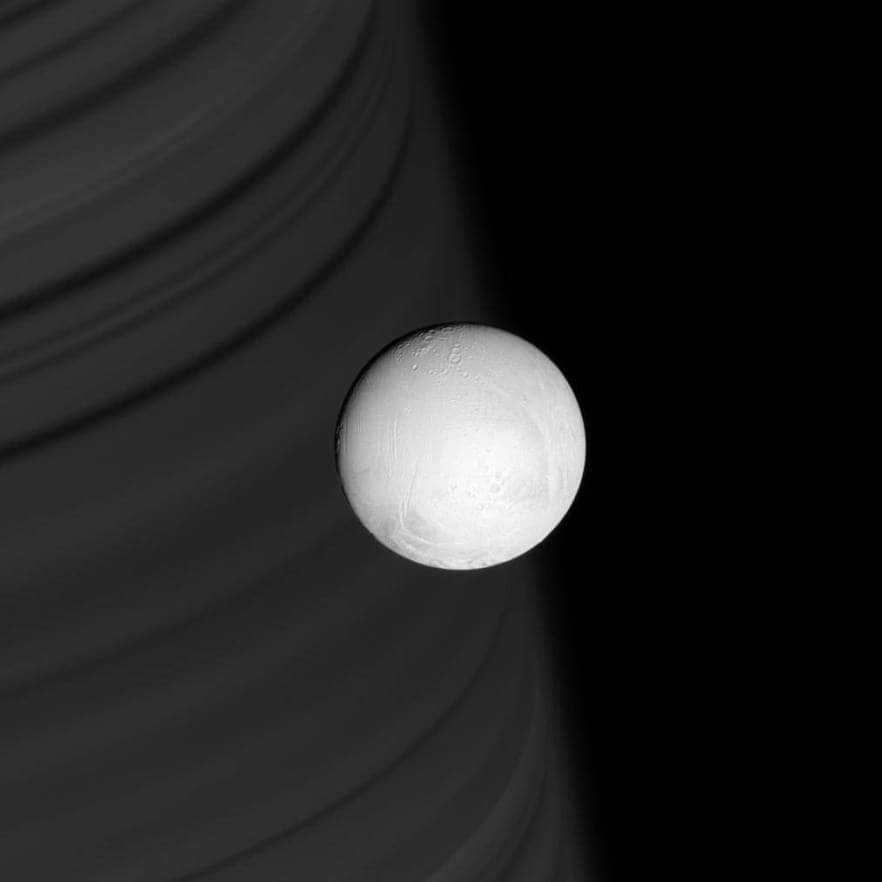
Ring shadows create a smooth effect on the distant Saturn, ensuring a stunning backdrop for the pristine sphere of Enceladus. Before you lies an icy moon with a modified surface and towering geysers of frozen material. Cassini directed its gaze during the equinoxes. This particular image showcases the leading hemisphere (measuring 313 km in width) illuminated in green light from a distance of 291,000 km. The flyby occurred on June 28, 2007. The spacecraft utilized its narrow-angle camera to capture this mesmerizing snapshot.
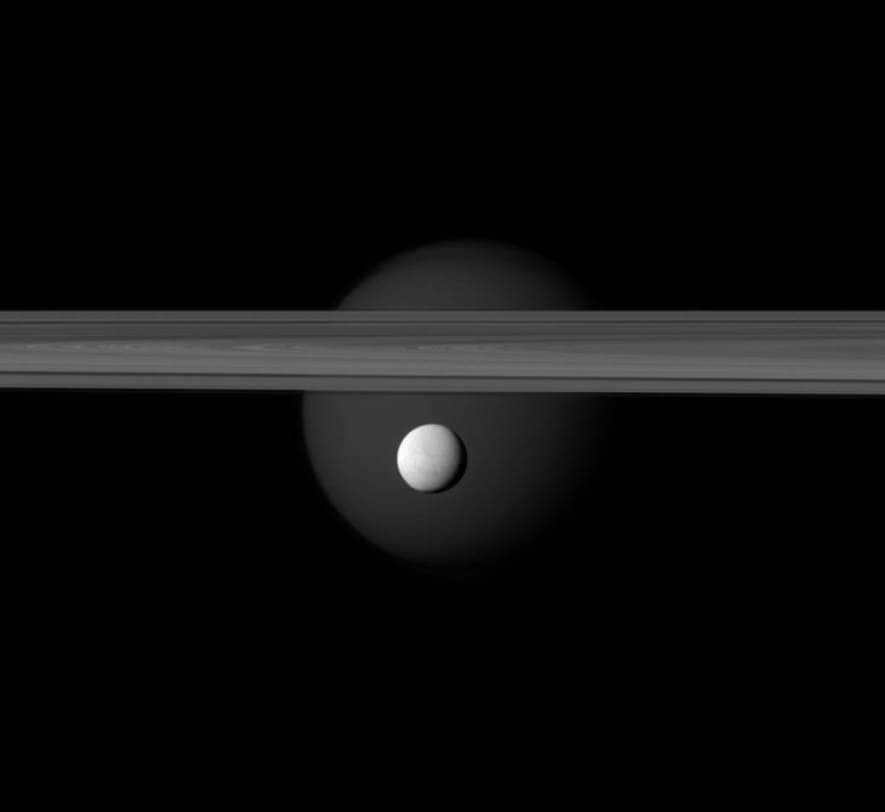
One of the indispensable romantic objectives of astronautics is the quest for alien life. Humanity is growing more pragmatic, with resources and engineers’ labor becoming more costly, and mistakes, though less frequent, more painful – but the desire to discover extraterrestrial life remains perpetually fresh, humanistic, and Efremovian. At least, the search for bacteria.
Today, I wish to revisit this subject because when such a dream is translated into practical terms, the initial question is answered: where shall we search for alien life? Currently, it appears rather evident: in places that are not excessively hot and possess liquid water.
Undoubtedly, our team is currently engaged in the active search and discovery of water on both Mars and the Moon. However, it is important to note that the climate on these celestial bodies cannot be characterized as hothouse-like. The presence of lakes on Mars is believed to be a remnant of its ancient hydrosphere, while the water on the Moon may hold greater significance for professionals in the domestic helium mining sector rather than exobiologists.
However, there exist regions in the Solar System where water is remarkably abundant. These regions pertain to the sizable moons of Jupiter and Saturn. Jupiter’s assortment comprises Europa, Ganymede, and Callisto, whereas Enceladus, Saturn’s icy satellite, stands out as the most intriguing one. Recently, fresh materials regarding the physical, chemical, and ecological aspects of Enceladus were published on Habra. Consequently, I firmly believe that it is essential to discuss not only the potential habitability of these massive satellites of gas giants but also the origins of water, the reasons behind its warmth in these areas, and the potential role of these moons in future unmanned and potentially manned explorations of the Solar System.
Therefore, let us summarize our current understanding of water in the solar system.
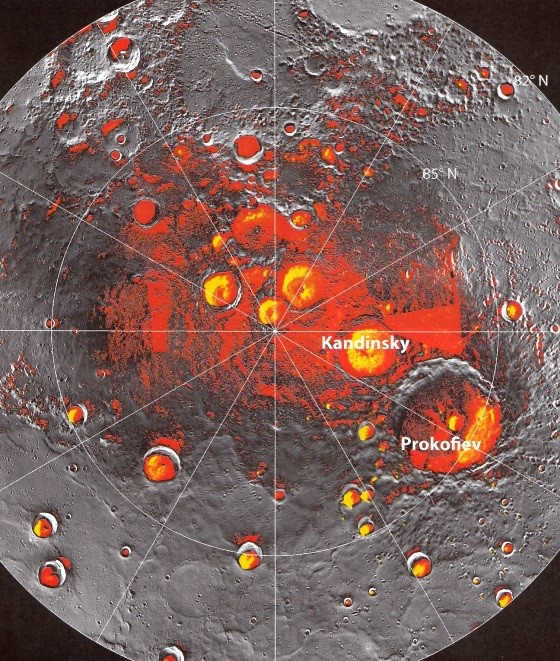
By the way, the esteemed Green Cat extensively covered this subject – that’s when I attended his lecture on the latest discoveries in planetology, which took place in Minsk at a loft near the Institute of Culture. I recall that the event was like a breath of fresh air or a demonstration of Hikpiknik; however, I was still quite distant from Hubr and primarily read Kot’s reports on LiveJournal.
On Mars, a combination of carbon dioxide (dry) ice and water ice can be found, whereas on Earth, methane ice has been discovered – it is deposited quite cheerfully and forms deposits on the ocean floor and in permafrost.
In addition, comets, as well as numerous bodies from the Kuiper belt, consist of various forms of ice, including water ice.
Therefore, ice, which includes water ice, is an unremarkable and ordinary entity in the vicinity of outer space. However, liquid water is a precious commodity due to its ability to stay in a liquid state within a very narrow range of habitable conditions… even on expansive satellites.
Aquatic presence on celestial bodies
The most sizable satellites of Jupiter, which were originally observed by Galileo, consist of Ganymede, Europa, Callisto, and Io. Saturn also boasts its own substantial satellites, including Titan, Rhea, Dione, Japet, and Enceladus. Titan, the second largest satellite in our solar system (after Ganymede), possesses a formidable atmosphere, while Enceladus is particularly intriguing in the context of this article. Additionally, Triton, the largest satellite of Neptune, is worth mentioning.
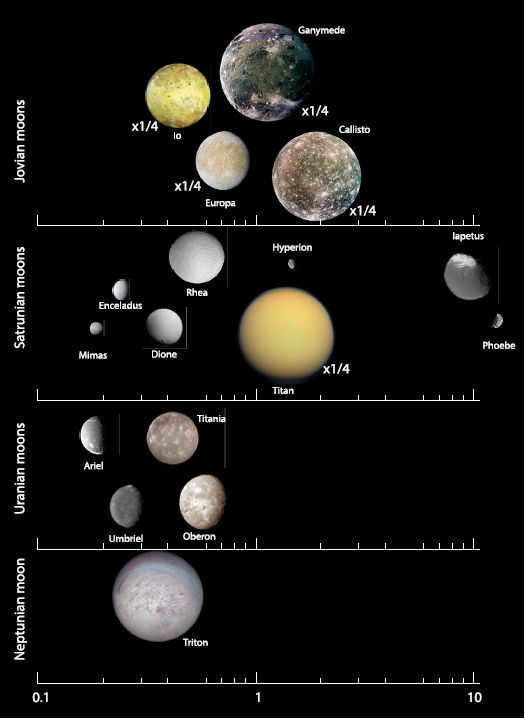
This image is sourced from this website. The horizontal line depicted in the image represents the satellite’s distance from the planet, measured in millions of kilometers.
All gas giants in our solar system possess numerous sizable satellites, with many of them being abundant in basic hydrogen compounds, such as methane and water. Below is a comparison of the sizes of some of these satellites in relation to the size of Earth:
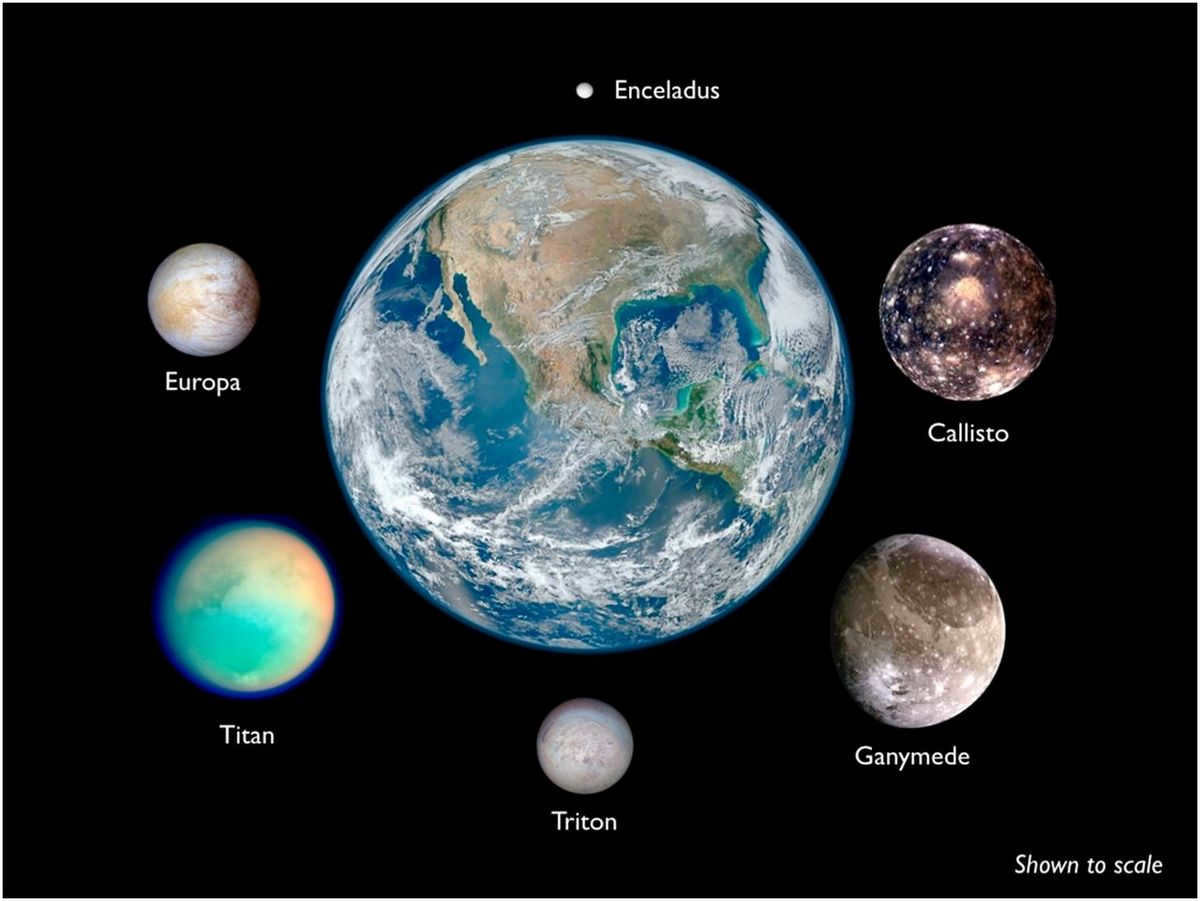
What is the reason for the high temperature?
Jupiter and other large planets are located far from the habitable zone and their moons receive very little solar heat. However, these moons, particularly Europa and icy Enceladus, seem to have vast oceans of salty water. The heat inside these moons is generated by tidal forces. As the moon orbits, it tries to move away from its planet, but the planet’s gravity keeps it in place. This constant tug of war causes the moon to become slightly deformed and heat up. The most fascinating result of these tidal forces is not just the presence of water on these moons, but the unique volcanic activity observed on Io. Let’s delve into the details of this specific moon.
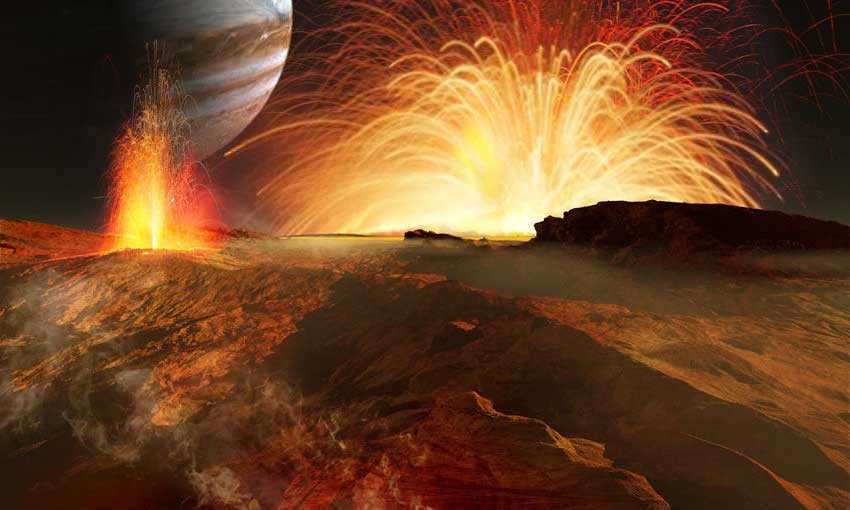
What is the source of the water?
How can water accumulate in such large quantities on the massive moons of gigantic planets? It appears that this is where the intricate dynamics and thermodynamics that unfolded during the formation of gas giants from the protoplanetary disk come into play. In fact, gas giants formed their own miniature “solar systems”. The gas giant planet itself is primarily composed of hydrogen, which, however, is insufficient to ignite thermonuclear fusion and transform the planet into a star. But a violent accretion process occurred around the giant planet: the giant was surrounded by a swarm of small and minuscule particles. The dust rapidly mingled with the hydrogen clouds of the planet, and the larger solid bodies (referred to as “pebbles” in the aforementioned article) became not only gravitational attractors for relatively dense minerals from the protoplanetary disk (silicates), but also objects on which hydrogen-containing compounds (water, ammonia, methane) denser than hydrogen itself condensed. It is highly probable that the giant planets managed to capture complete planetesimals in their vicinity, which eventually gave rise to the largest of their moons.
Not far from Jupiter, at a distance of approximately 2.7 astronomical units from the Sun, lies the “freezing line” or “snow line”. On the other side of this line, compounds containing hydrogen remain in a stable state as solids or liquids and do not evaporate. This is the reason why there are numerous planetesimals beyond the snow line and why the giant planets have formed extensive satellite systems, with Saturn and Uranus also developing rings. These celestial bodies, including the shadowed side of Io, are constantly or periodically covered in “snow”. For instance, in 2018, the ALMA telescope discovered that temperatures on the shadowed side of Io can plummet to -168 degrees Celsius, with an average temperature of around -150 degrees Celsius.
However, when we consider a less extreme example, such as Io, the situation becomes evident: a large satellite can develop a thick ice crust if it has a rocky (silicate) core and is constantly affected by tidal forces. This ice crust may enclose a vast ocean of liquid salt water or a layer of amorphous ice. But let’s discuss this in a systematic manner.
In 2004, the journey began when the Cassini-Huygens mission arrived in the vicinity of Saturn. The Cassini probe was designed to orbit Saturn and examine its rings and satellites, while Huygens was meant to land on Titan, Saturn’s largest moon that happens to have its own atmosphere. The primary focus of the scientists analyzing the data from Cassini was to study Saturn’s rings, the planet’s magnetic field, and with the assistance of Huygens, explore Titan. However, in July 2005 and November 2006, as Cassini flew past the south pole of Enceladus, it captured these thermal maps:
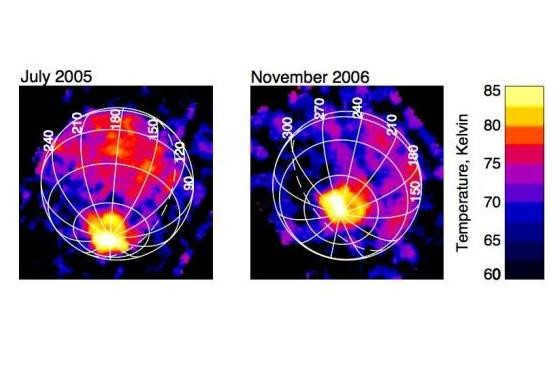
It has been discovered that real geysers, which are jets of crystalline ice, burst out from cracks in the ice on Enceladus. These jets are significantly warmer than the surrounding surface, with temperatures reaching -93 degrees Celsius. This has led to the hypothesis that there may be liquid water beneath the ice crust of Enceladus. In 2009, the Max Planck Society website published an informative article about the exploration of Enceladus geysers. The article provides a comprehensive overview of the composition, physical properties, and chemical properties of these fountains. The authors of the article propose the existence of a deep salt lake at the south pole of Enceladus, which was observed by Cassini.
“Scientists are questioning whether there is still ongoing convection, and if tidal warming alone is sufficient to account for the subglacial currents. Nevertheless, observations indicate that the interior of the moon is warm enough to prevent the freezing of the lake water and sustain geyser activity. Recent measurements from the Cassini-Huygens mission’s Cosmic Dust Analyzer (CDA) spacecraft suggest that there is indeed a subglacial lake on Enceladus. Many years ago, planetary scientists hypothesized that if there was a reservoir of water beneath Enceladus’ icy crust that extended to the moon’s warm core, sodium chloride and other salts would need to be extracted from the core’s minerals. Sodium has already been detected by the CDA mass spectrometer. The Max Planck Institute for Nuclear Physics in Germany analyzed data on 1,000 particles collected from Saturn’s E ring, which is the second ring from the edge. All of these particles range in size from 1 to 1/10 micrometers, similar to the size of cigarette smoke. “They are primarily composed of water ice,” notes Frank Postberg from the Max Planck Institute for Nuclear Physics, “but approximately 6% of the particles have a different composition, containing up to 6% salts, mostly sodium chloride. Sodium chloride, also known as table salt, is highly concentrated in Earth’s oceans.” Spectral analysis also reveals the presence of calcium carbonate, calcium bicarbonate, and minor amounts of potassium salts. A planetary scientist from Heidelberg, who has a background in physics and chemistry, suggests that these compounds originate from a salt lake because water can only lift salt upward when it is in a liquid state. When the water droplets erupt above the ice crust as an aerosol, they freeze and are propelled even higher by vapor streams. Most of these droplets likely fall back to the surface after the eruption, but some enter orbit and become part of Saturn’s rings. The chemical conditions present in the hidden lake beneath Enceladus’ ice sheet persist in these droplets. The majority of the particles studied from the E ring (around 90%) contain very little salt, similar to distilled water. Postberg believes that these droplets come from a cloud of water vapor above the lake. They form when the vapor stream condenses into pure water ice particles.”
The question of whether Enceladus contains solely a lake at its south pole or an entire ocean is still unresolved, but the measurements of its libration (wobble) taken in 2018 provide stronger evidence in favor of the presence of an ocean. The current understanding of Enceladus’ structure is depicted as follows:
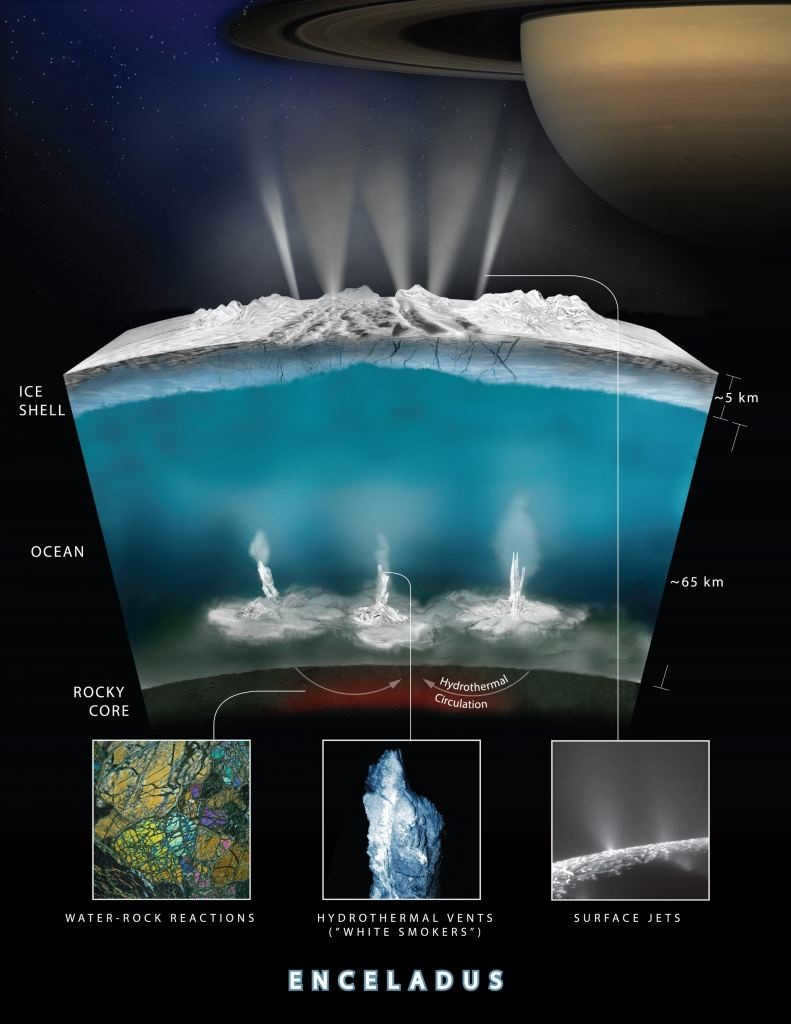
Envious Juno
In the ancient Roman religion, Juno was the wife of Jupiter and she endured his many acts of infidelity while remaining vengeful and cruel to his rivals. It is interesting to note that many of Jupiter’s moons are now named after these rivals. Juno was so highly regarded that the NASA spacecraft launched in August 2011 to study Jupiter was named after her. Its primary mission was to gather data on Jupiter’s magnetic field, water content, ammonia content, and to capture images of the polar regions. These objectives were successfully achieved by 2016, and “Juno” became an artificial satellite of Jupiter. However, in 2021, a new series of studies is planned using Juno – it will complete another 42 orbits of the planet and explore all of the major (Galilean) moons, as well as Jupiter’s rings. The most significant aspect of this new program is the investigation of water reserves on these moons. In 2015, the existence of an underground ocean on Ganymede was hypothesized, as polar lights were observed in its atmosphere. The pattern of these lights suggested that they were influenced by a strong source of underground magnetism, possibly caused by a saline solution.
Summary
The review provided above regarding recent and planned missions dedicated to studying the satellites of giant planets is by no means exhaustive. It is my belief that the story of Titan warrants its own separate publication, and I intend to prepare one in the near future. To conclude this article, I would like to emphasize that the search for water and life on the satellites of giant planets is a remarkable example of serendipity. Despite our current inability to discover even a trace of life on these large satellites, we have unexpectedly uncovered fascinating details about them, ranging from the examination of the amorphous structure of ice formations on these celestial bodies to the exploration of cryovolcanoes – incidentally, a similar object to a cryovolcano was recently discovered in Russia – as well as the observation and explanation of the extraordinary auroras on Ganymede. Regardless of whether life is discovered, the availability of clean water and genuine ice will undeniably prove invaluable for our future exploration of the solar system. In line with the current zeitgeist, researcher Julie Rezban (Dr. Julie Rezban, Ph.D. Julie Rathbun) from the University of Ithaca, NY, has initiated the hashtag #PlanetsAreOverrated, asserting that “satellites are much more captivating.” I wholeheartedly concur with her sentiment.
Powerful catastrophic asteroid impacts may have caused significant changes to celestial bodies such as Enceladus and Mars. These impacts created conditions that either allowed life to emerge or prevented it from flourishing. The question remains: why did Saturn’s satellite become hospitable to Earth-like organisms, while a similar event had no positive effect on Mars?
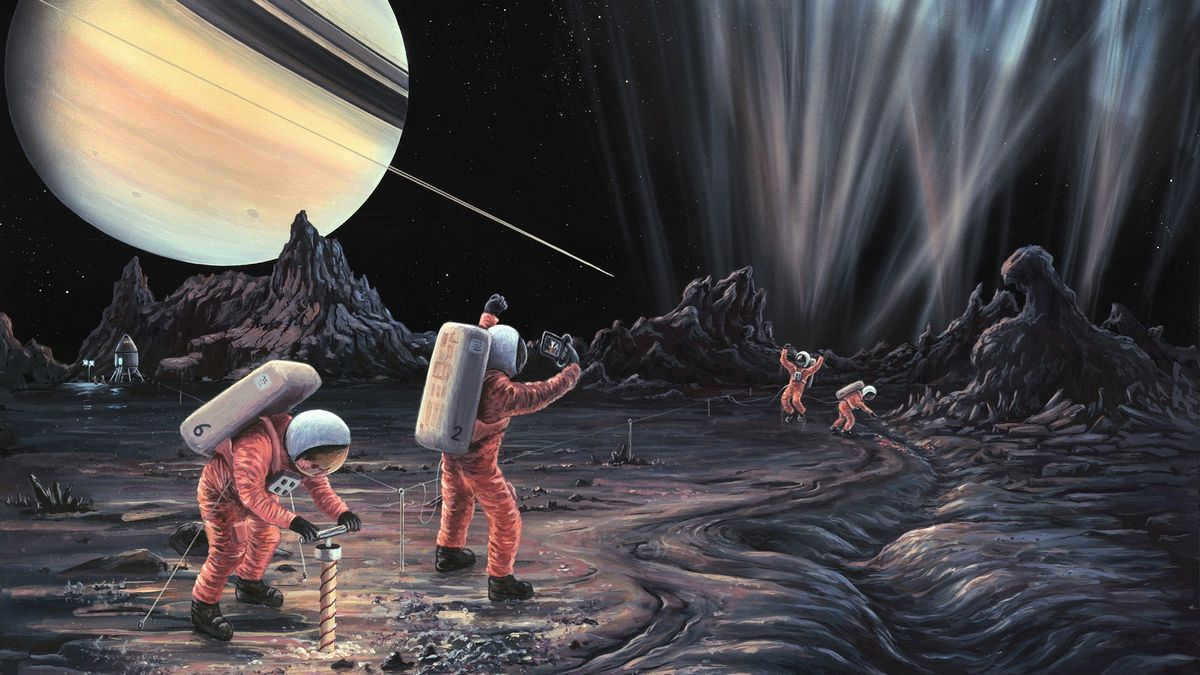
Breaking news! The recent discovery made by the Cassini probe is truly remarkable – it has detected hydrogen, carbon dioxide, and ammonia in the water vapor emitted from the geysers of Enceladus. This finding carries immense significance as it reveals the presence of hydrothermal vents, similar to those that existed on Earth billions of years ago, where the first forms of life, known as LUCA (Last universal common ancestor), originated. It is fascinating to think that these vents could potentially hold the key to understanding our own evolution as human beings.
The kettle is not big enough
When astronomers observed Enceladus solely through telescopes, they had a clear and understandable understanding. However, in 1981, Voyager 2 provided the first concrete data – and immediately caused confusion. Surprisingly, this small celestial body appeared to be geologically active, with very few visible craters. The activity posed a puzzle, as Enceladus is exceptionally small and, according to theoretical expectations, its interior should have cooled down long ago. Furthermore, its surface consisted of bright and pristine water ice, making it the brightest among all known planets and satellites. Enceladus reflects 99 percent of the incident light, surpassing even the purity of snow on Earth. According to expectations, it should have darkened like other icy bodies in the solar system, accumulating dust over time.
“Cassini” got even closer to Enceladus than “Voyager 2” did, and it also has a radiogravimeter. It was discovered that there is an ocean at least 10 kilometers deep near the south pole of the moon. From this ocean, geysers shoot up to heights of 250 kilometers!
On April 14, 2017, it was revealed that as “Cassini” passed through the upper part of the geysers, it detected not only water vapor, but also hydrogen, carbon dioxide, and ammonia. So much of these substances have escaped from the geysers that they have formed Saturn’s outer ring, known as the E ring!
What is particularly significant is that Earth has long been aware of the existence of single-celled methanogens, which thrive by consuming hydrogen and carbon dioxide and converting them into methane and water. These microorganisms are highly prevalent on our planet and can even survive in extreme environments, such as several kilometers below the ocean floor. Enceladus, a moon of Saturn, is now known to release significant amounts of hydrogen and carbon dioxide from its hydrothermal vents. This discovery has sparked the hopeful anticipation of many scientists who believe that it may harbor life.
The revelation is astonishing not just due to the possibility of encountering primitive extraterrestrial life forms. The existence of a liquid ocean on Enceladus and the presence of hydrothermal vents at its depths pose a perplexing enigma. Picture yourself strolling across the tundra when suddenly you stumble upon a minuscule kettle emitting a continuous stream of steam. The volume of steam is so immense that it has shrouded the entire vicinity in a dense fog. This phenomenon has extended over a vast expanse, equivalent to the diameter of Saturn’s ring E, which spans nearly one million kilometers, with a width of up to 300,000 kilometers. In order for a kettle to continue boiling after 4.5 billion years, which is the same age as Earth, the Moon, and Mars, it must be exceptionally large and extraordinarily hot. The Moon and Mars, for instance, are smaller than Earth and have ceased boiling long ago. Enceladus, on the other hand, is 55,000 times lighter than our planet. Therefore, the presence of unfrozen subglacial saltwater on Enceladus raises the question: why does it exist?
Is the planet young and therefore hot?
In 2016, researchers proposed a clever solution to the problem. They used the Cassini gravimeter to measure the stiffness of Saturn’s solid core, and were surprised to find that it was larger than expected. This rigidity is closely related to the rate at which moons move away from their host planets. Most moons in the solar system gradually drift away from their planets, much like the Moon moves away from Earth. The higher the rigidity of the planet, the less it is deformed by the gravitational pull of its moons. With Saturn’s high rigidity, less energy is spent on deforming the planet and more is spent on altering the orbits of its moons.
This explanation appears to have effectively covered all the bases. If a compact kettle has been actively boiling for 100 million years as opposed to the estimated 4.5 billion, it becomes considerably more comprehensible why it has not yet cooled down and why the water within it has not had sufficient time to evaporate. The presence of vibrant and pristine ice on Enceladus is likewise a sensible consequence of this moon’s relative youth, given the limited time available for dust accumulation on this satellite of Saturn.
An Unusually High Temperature, Especially for a Young Planet.
Unfortunately, straightforward and reasonable theories work well in articles and textbooks, but they don’t always hold up in the face of harsh reality. European scientists have examined recent data from the Cassini spacecraft’s observations of the southern pole of Enceladus in the microwave spectrum. They have discovered that the ice near the fractures is actually 20 kelvins hotter than what was predicted by all previous calculations.
Despite being the same age as the Tyrannosaurs, Enceladus has a subglacial ocean at its south pole that is surprisingly warm, with a relatively thin layer of ice above it, measuring only a few kilometers, perhaps a couple of kilometers. In comparison, the ice over Lake Vostok in Antarctica is twice as thick as the ice covering Enceladus’ ocean. This raises the question: how is it possible for the ice to be thicker over Lake Vostok when Enceladus experiences temperatures of minus 200 degrees and receives more heat from Earth’s interior than from a 500-kilometer ice body? Moreover, another puzzling question arises: why is there an ocean at Enceladus’ south pole but not elsewhere on the satellite?
The asteroid is becoming hotter
In order to clarify the unusual phenomenon, a different team of scientists attempted to simulate the potential occurrence of an ocean, with a depth of several kilometers, forming at one of the poles while not existing elsewhere. Their findings revealed that such a scenario is feasible. This occurrence could transpire if a sizable satellite were to collide with a massive asteroid, measuring tens of kilometers in diameter. Upon impact, such a celestial body would produce an explosion of immense proportions, equivalent to hundreds of millions, or even billions, of megatons.
A transformative jolt
The impact on the livability of Saturn’s moon has been transformative. The water vapor escaping from the geysers contains grains of sand, known as silica particles. As a result, the water interacts with the rocky core of the moon and absorbs salts and various elements. The ocean beneath Enceladus’ thin icy surface is rich in salts and basic organic matter, and it is notably warm – otherwise, hydrogen would not be present in the water vapor. This warm environment is created through a process called serpentinization, which involves the interaction of solid rocks, such as olivine, with water at high temperatures. During this process, iron removes oxygen atoms from the water and releases hydrogen atoms.
Within the Earth’s crust, similar activities are taking place, with organisms known as methanogens absorbing hydrogen and generating methane. These methanogens have been utilizing hydrogen as a source of nourishment since ancient times. Consequently, the impact of the asteroid has provided this remote celestial body with the potential for sustaining life. As the ice on this body is relatively thin, inhabitants of Earth may eventually have the opportunity to explore and potentially encounter any indigenous life that may have already emerged or been introduced from our own planet.
A Disappointing Outcome
Regrettably, Enceladus is not the only celestial body with a fortunate fate. In 2016, scientists made a disconcerting discovery regarding Mars’ distant past. In a particular region, there was an abrupt onset of colossal volcanic eruptions, so intense that they gave rise to the largest volcanic province in the entire solar system. This province extends approximately six kilometers above the surrounding terrain. It is within this province that Mount Olympus, towering over 20 kilometers in height, can be found – a dual record holder as both the tallest peak and the loftiest volcano ever identified by humankind.
The Red Planet has been completely transformed by the eruptions and the impact crater caused by an asteroid on Enceladus. A massive volcanic formation has emerged on one side of Mars, weighing in at an estimated billion billion tons. This immense weight has caused the planet’s rotation axis to shift, resulting in the former poles now being located in the tropics. As a consequence, the ice in these regions has started to evaporate, and the planet’s geomagnetic dynamo has ceased to function. Evidence of magnetization in ancient Martian rocks suggests that there was once a magnetic field, which helped to prevent the loss of gases and water vapor from the atmosphere. If Mars had a magnetic field like Earth’s, this process would have taken billions of years. However, Mars is only one-tenth the mass of Earth, so it already had a deficit of light elements. With a gravity of just 0.38 times that of Earth, it is much more difficult for Mars to retain these elements without a magnetic field.
The identification of the cause of these exceptionally long and intense eruptions in the same location has sparked inquiry. The search for an answer has been ongoing, and significant evidence suggests that an asteroid may be the responsible party. Interestingly, on the opposite hemisphere of Mars from the volcanic region of Farsida, there is the vast plain of Hellas. This plain reaches a depth of nine kilometers and has a diameter of up to 2300 kilometers. To grasp the magnitude, it is worth noting that the entire diameter of the Red Planet is a mere 6800 kilometers.
This particular region bears the mark of a massive celestial object impact, commonly known as Hellas. In the 1980s, scientists put forward a theory suggesting that the impact of Hellas may have been the catalyst for intense and protracted volcanic activity in the Farsida region on the opposite side of the planet. When a celestial body collides with a planet, the shockwaves generated by the explosion, equivalent to billions of megatons, have no escape and ultimately converge on the antipodal point.
Father-in-law or gravedigger
The catastrophic asteroid impacts had varying effects on their respective target bodies due to their unique characteristics. Enceladus, being distant from the Sun and cold, experienced a significant increase in temperature and the formation of a long-lasting unfreezing ocean as a result of the mega-impact. On the other hand, Mars, being much closer to its star, suffered the loss of its atmosphere through the solar wind due to a similar impact that also left it without a magnetic field. This demonstrates how some entities can benefit from asteroid-induced heating while others already possess sufficient warmth. However, there exists a third possibility. If the Martian tragedy were to occur on Earth, our planet would be able to withstand it due to its greater mass compared to the Red Planet. Even without a magnetic field, our atmosphere and hydrosphere would endure for billions of years.
The tale of how an asteroid transformed the frosty pumpkin of Enceladus into a carriage housing a heated ocean, while having the opposite effect on Mars, serves as a reminder of the significant impact these celestial bodies have on the evolution of planets and moons within our solar system. It may be beneficial for humanity to pay closer attention to these “heavenly rocks.”
Related resources:
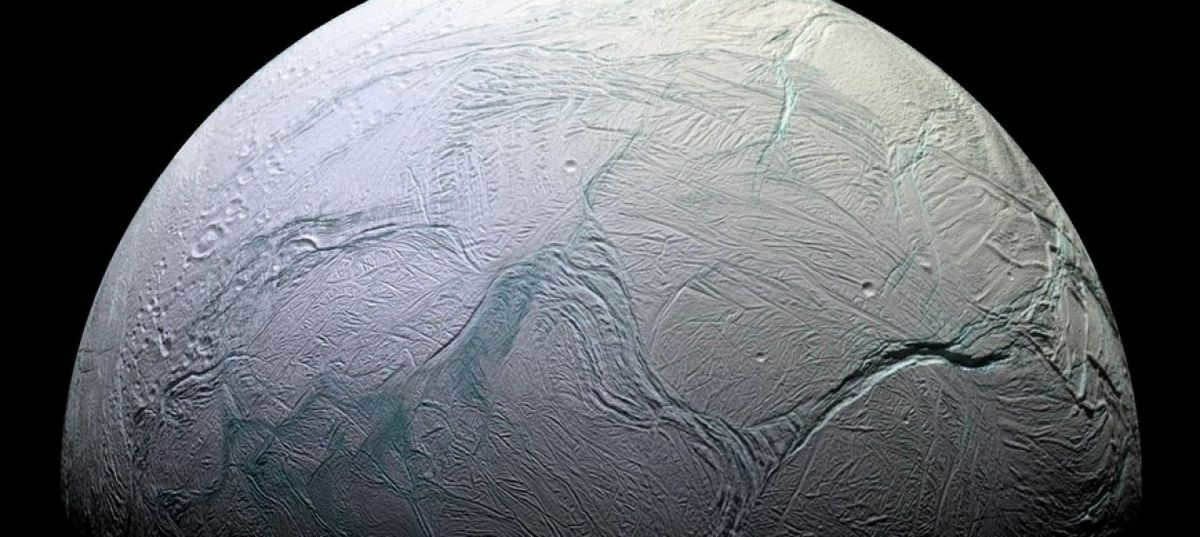
Enceladus is a moon that orbits around Saturn and has a distinctive round shape. It is the smallest among Saturn’s many moons, measuring about four hundredths the size of Earth. It completes one orbit around Saturn in approximately 33 hours, similar to how our Moon orbits around Earth with one side always facing us.
Enceladus is known for its unique appearance, as it reflects almost all of the sunlight that hits it. It is located in the “E” ring of Saturn, and it is believed to have played a role in the formation of this ring.
As for Enceladus’ atmosphere, it is relatively mild. About 91% of the atmosphere is made up of water vapor, while the remaining composition includes nitrogen (4%), CO2 (3.2%), methane (1.7%), and a few other impurities (approximately 0.1%). Due to the celestial body being covered in perpetual ice, the temperature on Enceladus is extremely cold, reaching as low as -198 degrees Celsius.
Due to the relatively low gravity of Enceladus (it is possible to escape the surface even at the velocity of a jet airplane – 860 km/h), the atmosphere would have dissipated by now. However, the fact that it still exists suggests that there is a consistent source maintaining it. It is probable that geysers or ice volcanoes are responsible for this phenomenon.
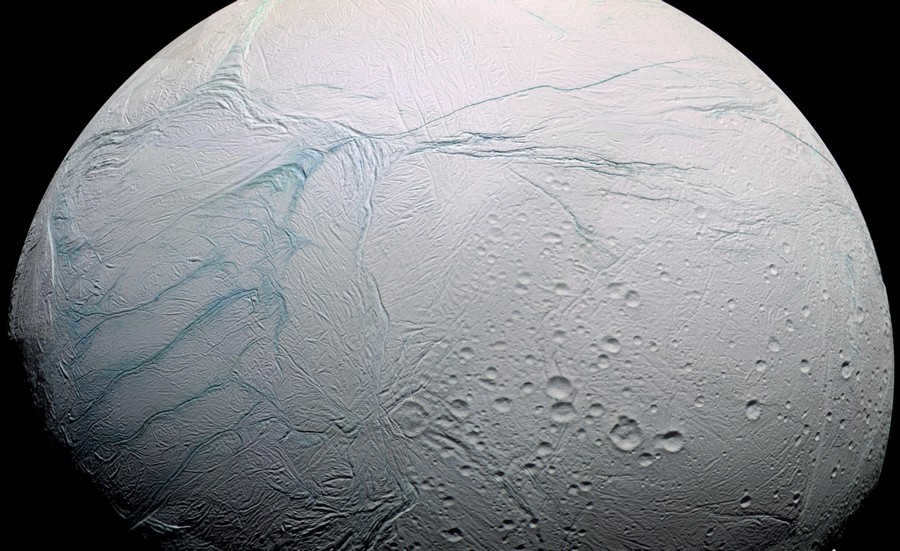
Surface
The surface of this Saturn satellite consists primarily of water ice, giving it a snowy-white appearance and reflecting most of the sunlight that hits it.
Although not completely smooth, the surface of Enceladus is relatively flat compared to other satellites. It features some craters, protrusions, cracks, and rifts, but they are not as prominent or large. This suggests that the satellite’s surface undergoes frequent renewal through cryovolcanoes.
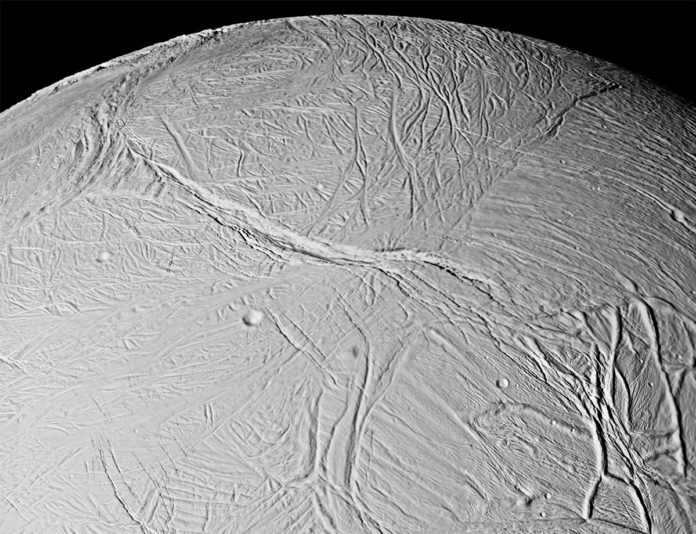
Fractures
Fractures, fissures, gaps – you can use any term you prefer. These are massive depressions that stretch over considerable distances (up to 200 kilometers) and are clearly visible in the images of the celestial body. Fractures resemble long, deep canyons. They can reach depths of up to one kilometer and widths of up to ten kilometers. Of particular interest are the undulating fractures that visually divide Enceladus into flat regions and regions with craters. In certain areas, the fractures even intersect at specific angles, creating a chevron-like pattern.
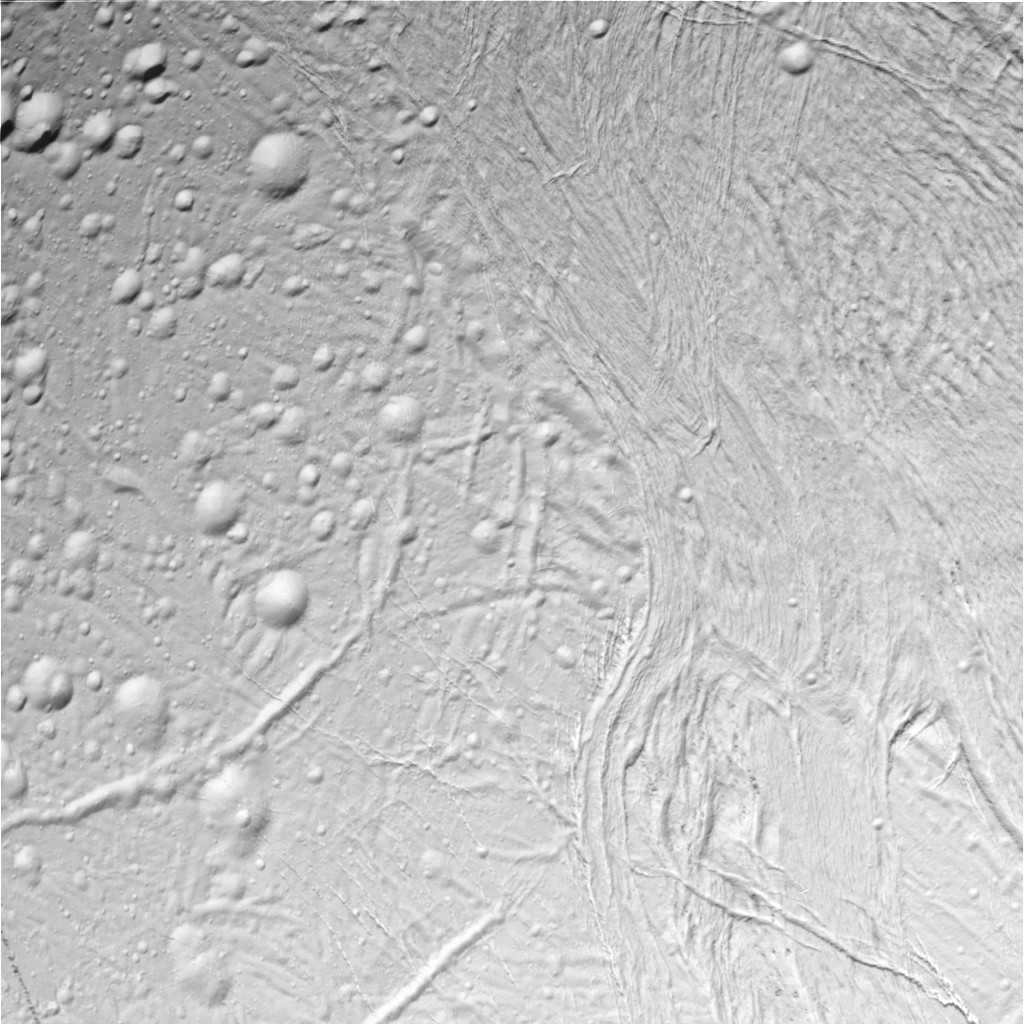
Impact Sites
The impact sites on the satellite exhibit a distinct variation compared to those observable on the Moon. They possess a flatter structure, resembling an inverted dome. This peculiar formation can be attributed to the influence of gravity.
Due to the continuous rejuvenation of Enceladus’ surface, nearly all of its flat terrains are relatively smooth and fairly young, dating back no more than 3.7 billion years. Indeed, youthfulness in the grand scheme of the cosmos carries a distinct perspective. The plains are seldom adorned with impact craters, while, conversely, the opposing regions boast an abundance of mountain ranges and other anomalies. It is plausible that these features are indicative of the planet’s tidal forces exerted upon the satellite.
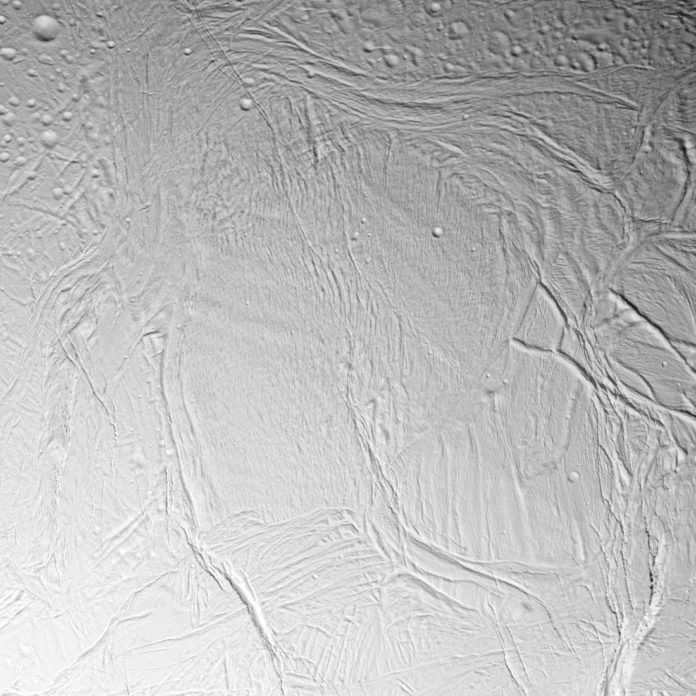
Region of the South Pole
Enceladus’ south polar region is the most recently formed area, with an estimated age of less than five hundred thousand years. It is characterized by four major faults, each measuring approximately 130 kilometers in length.
The southern polar region of the moon exhibits distinct differences from its northern counterpart. The lack of craters suggests a younger terrain, which could be attributed to variations in crust thickness. Additionally, the presence of ice geysers and volcanoes at the south pole, expelling ice particles hundreds of kilometers into space, further emphasizes its unique characteristics.
The exact cause of these phenomena on Enceladus remains unclear. It is possible that Saturn, with its tidal forces, induces such intense volcanic activity. Alternatively, the release of energy from radioactive decay could also contribute to these geological features.
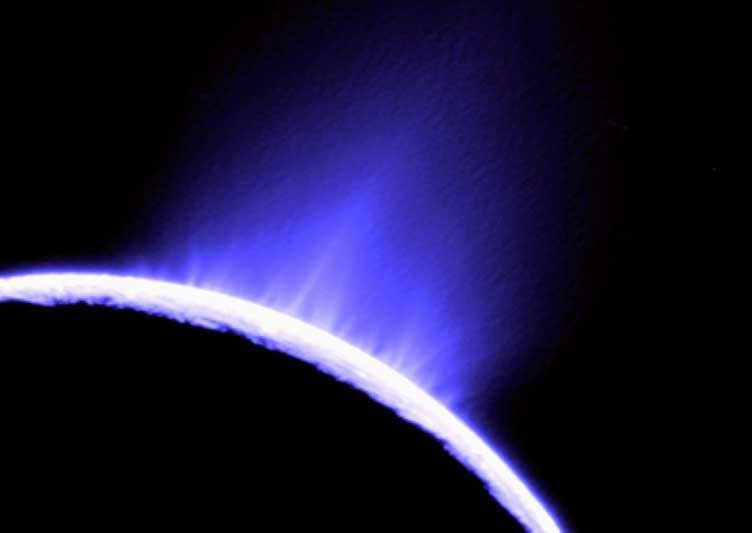
Structure inside
If Enceladus was formed like the rest of the gas giant’s satellites, then it must possess a solid core made of rock. The rest of the moon is primarily composed of ice, including the mantle and crust. It is possible that volcanic activity is triggered by the heat generated from the core, indicating the presence of molten areas.
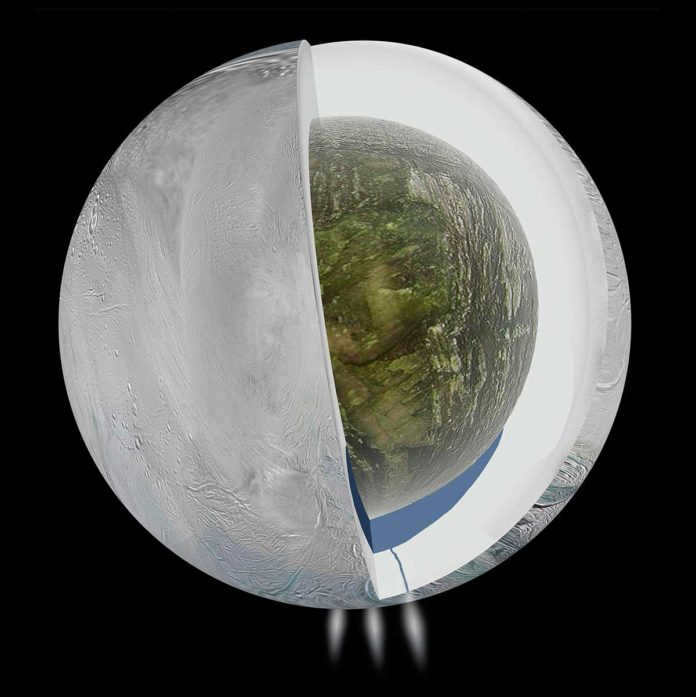
The underground sea
The underground sea is one of the most fascinating characteristics of Enceladus. The ice geysers provide strong evidence for its existence beneath the southern pole of the moon. It covers an area of approximately 80,000 km 2 , which accounts for about 10% of the moon’s total surface area. The depth of the underground sea reaches up to forty kilometers. The water temperature in the upper layers is relatively warm, around +1°C. However, as you go deeper, the temperature drops significantly and reaches -45°C. These temperature patterns are similar to the ones found in polar regions on Earth.
Microbes and bacteria have the potential to exist in various locations within the solar system, and Enceladus is particularly promising in this regard.
Initial indications of this possibility are derived from the presence of organic compounds discovered in the emissions released by its volcanoes. Furthermore, as you are aware, this satellite exhibits inherent hydrothermal activity and possesses a substantial liquid water ocean beneath its surface.
